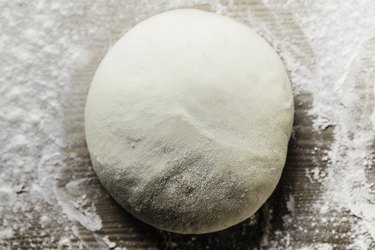
Some foods clearly reveal that they've gone bad, with notable mold, curdling or an icky odor. If you have pizza dough in the fridge, it's not always easy to identify if it's gone bad, especially if it's not in a package with a clear expiration date.
Look for some clues to determine if your pizza dough has gone bad. These can include a change in color or texture.
Tip
If you’re worried that your dough has gone bad, look for changes in odor, texture and color. Sometimes, older dough is still safe to eat, but loses quality.
Video of the Day
About Food Spoilage
Food spoils through exposure to light, oxygen, heat, humidity, the wrong temperature and bacteria. When exposed to these factors, to varying degrees, food loses its quality and safeness for consumption, explains the USDA.
Video of the Day
Proper storage goes a long way toward preventing the deterioration or spoilage of food, including prepared pizza dough. If you have pizza dough in the fridge, make sure the temperature of your appliance is 40 degrees Fahrenheit or below. An appliance thermometer can help you be sure of the temperature, explains the Department of Health and Human Services. Bacteria multiplies most quickly between 40 and 140 F.
If you followed your own pizza dough recipe, the completed dough (after it's proving) should not be left out on the counter more than two hours. Never taste raw dough, says the Centers for Disease Control and Prevention. Even it doesn't contain eggs or milk, the dough still poses a risk of contamination.
Pizza Dough in Fridge Expiration
Prepared dough, such as Trader Joe's pizza dough, is convenient, but it doesn't last forever. One of the first clues that the dough isn't suitable for consumption is the expiration date on the package. If it's past this date, be safe and throw out the pizza dough.
If you followed your own pizza dough recipe, determining when it is spoiled can be trickier. The raw dough may contain bacteria that causes disease, explains the Food and Drug Administration (FDA). Flour, regardless of the brand, can be contaminated. Instances of food poisoning from consuming raw flour have been documented by the FDA.
If you make a pizza dough recipe with water, it can be refrigerated for up to five days, says Purdue University. If you have an unusual recipe that calls for milk, shorten that fridge time to just three days. When you're ready to make your pizza, shape it, top it and bake it according to recipe instructions.
Signs That Pizza Dough Spoiled
Obvious mold or an off-putting smell are both obvious signs that pizza dough in the fridge is spoiled. With many foods, you can tell they have spoiled when they have an "off" taste, but you don't want to bake spoiled dough and tasting it raw is not advised.
If you take the dough out of the fridge and its texture is diminished or it is exceptionally dry feeling, with a crusty appearance, it's probably past its prime. Put it in the bin.
Pizza dough that has a grey color, rather than a fresh white or beige one, or dough that has flecks of grey, is also likely spoiled. Pizza dough that's been stored in the freezer and has signs of freezer burn, such as whitish spots or visible freezer crystals, is also not any good. While eating dough with freezer burn isn't going to make you sick, it isn't too tasty and the dough may not cook correctly.